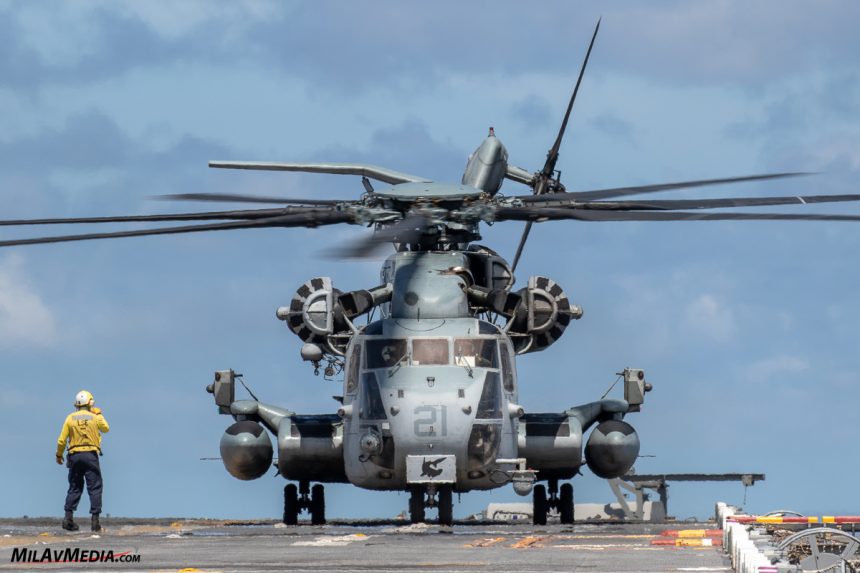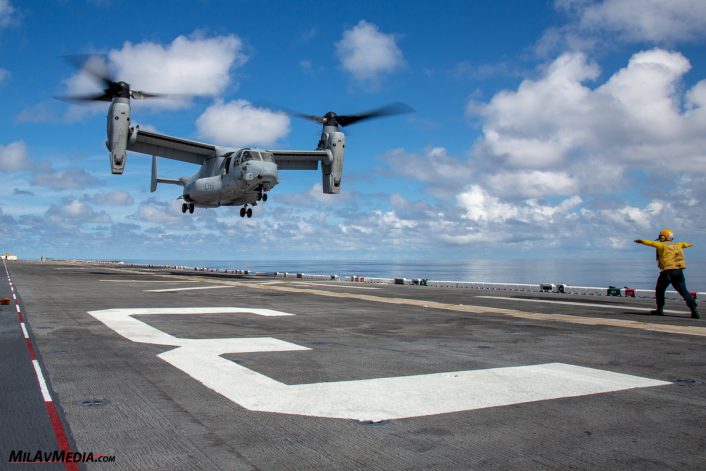The 22nd Marine Expeditionary Unit (MEU) Aviation Combat Element (ACE) VMM-264 (Reinforced) takes us on board the USS Kearsarge (LHD-3) during deployment work-ups.
Authoritative voices bark from the loudspeakers on the deck of the U.S.S. Kearsarge, a U.S. Navy Wasp-Class Amphibious Assault ship. Simulated threats are identified, and timely safety reminders regarding deck activity are made. Today, the deck is lightly loaded with only a handful of active and parked ACE assets from Marine Medium Tiltrotor Squadron (VMM)-264 (Reinforced). During deployment the parking area of the deck will be packed with the aircraft fitted together like a jigsaw puzzle.
This is the stage of pre-deployment workups when the 22nd MEU joins at sea with the Kearsarge ARG (USS Kearsarge (LHD-3), USS Arlington (LPD-24) and USS Fort McHenry (LSD-43)) and learns to function as one. The ARG/MEU must effectively execute everything from humanitarian relief to an amphibious landing on hostile shores (or with the MV-22B deep inland far from the sea).
Procedures ensure the highest degree of safety possible. Given the nature of the activity – danger is never far away. I observe activity on a hot, but otherwise perfect day. Add inclement weather, pitching decks and night operations – and one may grasp what risks these young men and women of the Marines and Navy face. The sea is inhospitable and the activity does not tolerate mistakes without consequence.
Aircraft launch and recovery, fuel and ordnance handling, hot arrivals and departures and much more are worked until they become second nature. Man and machine are put through grueling paces to serve as first responders to any number of global crises. No one is overlooked, maintenance and support professionals from VMM-264 work tirelessly on the relative austerity of the ship to ensure all platforms are ready to go.
The operational pace is high. Today, the exercise takes the form of a Visit, Board, Search and Seizure (VBSS) of an “over the horizon” vessel. VBSS is simply one of the many mission sets the Kearsarge ARG and 22nd MEU will work prior to deployment.
The Black Knights of VMM-264 have their machines at the ready along with US Navy MH-60S Knighthawks from the HSC-26 Chargers of Norfolk, VA. AH-1W Super Cobra gunships launch (I suspect Harriers would be up in the air already if this took place near hostile shore). The message is unmistakable, firepower is up in the air long before the Marines of BLT 1/2 arrive on the scene.
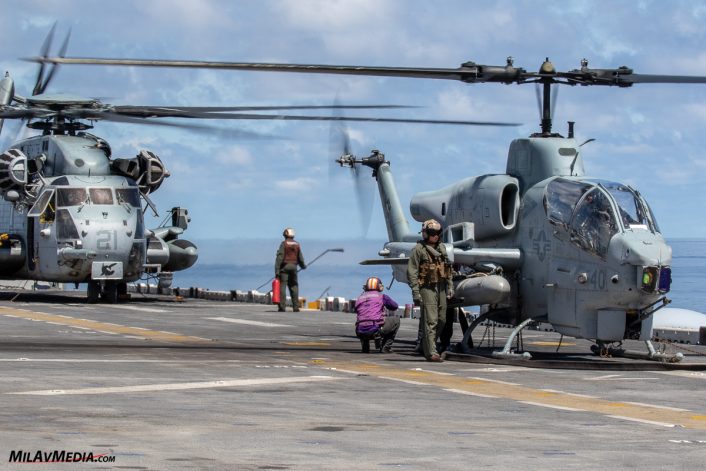
The MH-60 Knighthawks launch next – with observers and Marines. The CH-53E launches with what must be a full complement of combat ready Marines. Additional assets may have launched from other members of the Kearsarge ARG (USS Arlington and USS Fort McHenry).
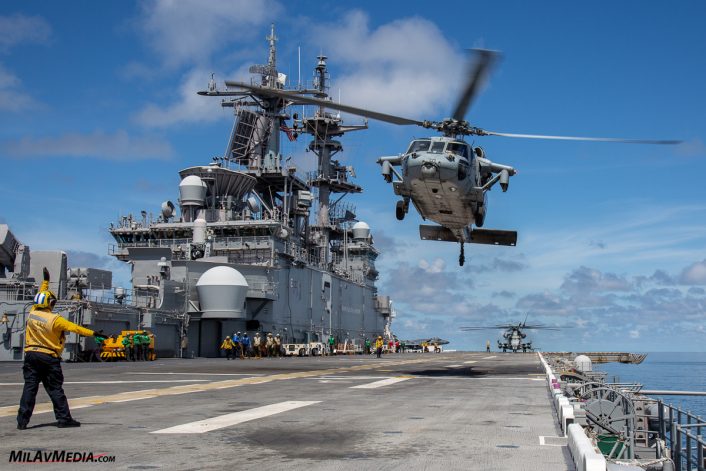
The U.S. Navy component, the ARGs has a primary objective – “deliver the warfighter to theater.” It is an impressive combined force. Nor can one overlook that the Navy has the option to add additional resources to the ARG and form an Expeditionary Strike Group (ESG) or add a Carrier Battle Group (CVBG).
Given the ARG delivers the Marines to theater, the Marines take the next natural step, putting their “warfighters on the ground, wherever that ground may be.” VMM-264 does their part. Seasoned pilots operating complex platforms capably night and day in good and poor weather in both friendly and hostile space. It is their responsibility to carry those warfighters safely to and from the ARG.
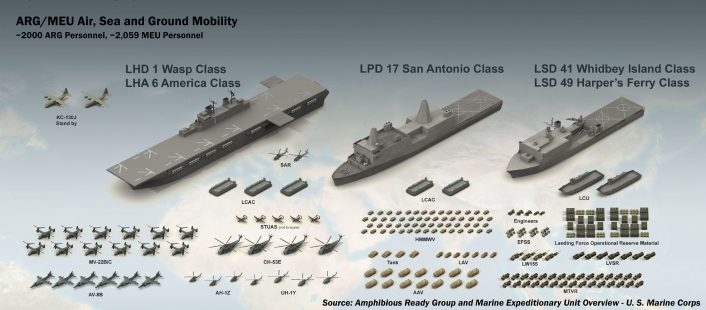
For many, the Marines are defined by the tenacious and bloody battles of the South Pacific in WWII. Rightly so. The great price paid by Marines in the past must be a large portion of the Marine Corps drive to excel at the mission today. Marines are doing exactly that, striving to build an indomitable force that will excel at the mission. The addition of the MV-22B has provided speed and range, enabling a massive mobility upgrade – landings deep inland. The AH-1Ws are well on their way to replacement by the more capable AH-1Zs, the AV-8B by the F-35B, some F/A-18s by the F-35C.
It all means that Marines will come ashore “at the place and time of their choosing” – even if that place and time is 100’s of miles inland. When they arrive, they will do so with unparalleled capability.
Silence falls, and activity turns to the basics. Moving aircraft and equipment about the deck to accomplish support work at hand. A handful of Marines (BLT 1/2) wait on board the Kearsarge, extra’s at the ready if required. They are geared up and wait patiently. As the afternoon passes they become aware that their presence is not required for the VBSS. The disappointment is accepted, but palpable. The blend of young and seasoned Marines joined the service for the very reason; to be “first in.” They are polite, disciplined, focused and to a Marine desire to be at the epi-center of the action. It is a privilege to encounter them as friend, and to know they are forward deployed around the globe to respond to any number of crises.
The Aviationist expresses gratitude to the II MEF USMC Communcations, Strategy and Operations team, Capt. Joshua L Smith (22D MEU), SSgt. Melissa L. Karnath and Maj. Jordan R. Cochran (II MEF), the entire US Navy Public Affairs team on the USS Kearsage.

